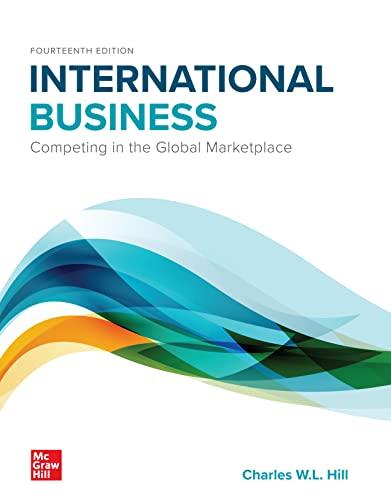Back in the 1950s, China was a one-party state ruled by the Communist Party. Private enterprise was
Question:
Back in the 1950s, China was a one-party state ruled by the Communist Party. Private enterprise was banned, economic activity was dictated by central planning, and state-owned enterprises played a dominant role in the country’s industrialization. This Marxist model failed to deliver economic gains and, beginning in the late 1970s, the communist government gradually began to launch market-oriented reforms. These reforms accelerated throughout the 1980s and 1990s. They included the removal of price controls, the privatization or liquidation of many smaller state-owned enterprises, the growth of the private sector, the development of stock markets, and the opening up of the economy to international trade and inward investment by foreign multinationals. The reforms helped to make China one of the fastest-growing economies in the world, with gross domestic product (GDP)
increasing more than tenfold between 1978 and 2018. By 2020, China was the world’s second-largest economy behind the United States, measured by nominal GDP, and the world’s largest measured by GDP on a purchasing power parity basis.
Today, China remains a one-party state ruled by the Communist Party, but it now operates with what is essentially a mixed economy, comprised of a vibrant private sector and a significant state-owned sector. The Chinese refer to this as a “socialist market economy.” Major multinational tech companies such as Alibaba, Tencent, Baidu, and Huawei have come to symbolize the country’s private sector. However, the country still has a significant number of large state-owned enterprises. According to a study by the World Bank, in 2017 state-owned enterprises accounted for 27.5 percent of the country’s GDP. Stateowned enterprises are concentrated in certain sectors. In banking, they account for an estimated 88 percent of value added, in transportation and postal services 77 percent, in construction 38 percent, in wholesale and retail activates 37 percent, and in manufacturing industry around 21 percent. On the other hand, state-owned enterprises account for less than 10 percent of value added in information technology, hotel and catering, and agriculture, among other sectors.
China has used its state-owned enterprises in a strategic manner to help drive economic growth, combining the invisible hand of the market with the visible hand of the state. This is most evident in areas such as infrastructure, where state-owned enterprises have been at the forefront of building the country’s rail and road networks, its shipping ports and airports, and its high-speed wireless networks. It is also an obvious factor in heavy industries such as steel, where three of the largest five producers are state owned, or automobiles, where the top four companies are state owned.
Less obviously, the state has also helped foster the development of private enterprises in certain sectors. For example, research by The Wall Street Journal suggests that Huawei, a private company and China’s largest vendor of telecommunications equipment, may have received as much as $75 billion in state support in the form of grants, cheap land, credit facilities, low-interest rate loans, and tax breaks since 1995. China’s large state-owned banks have been a major conduit through which the state has funneled supported to Huawei. China Development Bank and the Export-Import Bank of China, both state-owned banks, have reportedly made available more than $30 billion in credit lines for Huawei’s customers since 2000. All of this support has helped Huawei offer generous financing terms to its customers, undercutting the prices of its rivals by as much as 30 percent and powering Huawei to the top rank of global telecommunications companies. For comparison, Huawei’s largest competitor, Cisco Systems, received $44.5 million in state and federal subsidies, loans, guarantees, grants, and assistance since 2000.
The proactive role of the state in China’s enterprises has certainly created some problems. Numerous studies have shown that China’s state-owned enterprises are less productive than private-sector business, no matter how much support they receive from the state. China’s subsidization of both state-owned enterprises, such as the steel companies, and private companies such as Huawei, have also created tensions with the country’s major trading partners, and most notably the United States. The Obama administration argued that the state-subsidized steel sector was dumping excess steel production on world markets and slapped punitive tariffs on Chinese steel imports. The Trump administration took this approach further, launching an all-out trade war with China and imposing limits on the ability of companies like Huawei (which the administration feared is an arm of the Chinese state) from doing business in the United States. There are signs this confrontational approach is starting to bite. China’s economic growth rate has slowed significantly in the last 8 years from around 10 percent to 6.1 percent in 2019. To date though, there are few signs that the Chinese government is willing to pull back from its state-directed mixed private-/
state-owned economic model.
Case Discussion Questions 1. How would you describe China’s economy prior to the market-based reforms of the 1980s and 1990s. This system failed to deliver rising living standards to the bulk of China’s population.
Why?
2. How would you describe China’s current economic system? What are the benefits of this system? What are the potential drawbacks?
3. Would China be better or worse off, economically, if it privatized more of its substantial state-owned sector?
4. Do you think the Chinese enterprises that received substantial funds at below-market interest rates from state-owned banks, such as Huawei, should be allowed to compete in international markets against private companies that received no such assistance? What policy remedies, if any, would you suggest here?
Step by Step Answer:

International Business Competing In The Global Marketplace
ISBN: 9781260387544
14th Edition
Authors: Charles Hill





